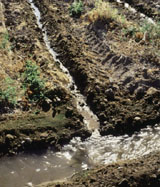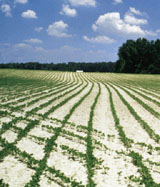| Concentrations of nutrients and pesticides generally
are higher and more prevalent in streams than in ground water; however,
indications of emerging ground-water contamination are important because
ground-water contamination is difficult to reverse. Ground-water flow
rates are slow, and a contaminated aquifer can take years or even
decades to recover. |
|
Contamination of major aquifers is largely controlled by hydrology
and land use
Concentrations of nutrients and pesticides in 33 major aquifers generally
were lower than those in shallow ground water underlying agricultural
and urban areas. Water that replenishes the major aquifers is derived
from a variety of sources and land-use settings, and includes high-quality
water from undeveloped lands. In addition, deeper aquifers generally are
more protected than shallow ground water by relatively impermeable materials.
Contaminants are most prevalent in major aquifers located in vulnerable
geologic settings that allow rapid vertical movement of water from the
shallow ground-water system. For example, in 4 of 33 major drinking-water
aquifers sampled, the USEPA drinking-water standard for nitrate was exceeded
in more than 15 percent of samples collected. All four aquifers are relatively
shallow, in agricultural areas, and composed of sand and gravel that is
vulnerable to contamination by land application of fertilizers. Water
in one-third of wells sampled in major aquifers contained one or more
pesticides, but only one well had a pesticide (atrazine) concentration
that exceeded a drinking-water standard.
Hydrology and land use also are major factors controlling nutrient
and pesticide concentrations in major rivers
Concentrations of nutrients and pesticides in major rivers reflect the
proportion of urban and agricultural land in the drainage basin. River
basins with large proportions of agricultural and (or) urban land had
concentrations of nutrients and pesticides that were similar to those
in smaller agricultural and urban streams. The greatest variety of pesticides
occurred in basins draining both agricultural and urban land. Concentrations
of nutrients and pesticides were moderate in major rivers draining mixed
land uses because of dilution by water from undeveloped areas. None of
the major rivers exceeded drinking-water standards or guidelines, although
the consistent presence of pesticide mixtures remains a concern. Guidelines
for the protection of aquatic life were exceeded in water at 36 percent
of river sites sampled for currently used pesticides. Sediment-quality
guidelines were exceeded at 11 percent of sites for DDT and other historically
used insecticides, whereas concentrations of these compounds in whole
fish exceeded guidelines for the protection of fish-eating wildlife at
24 percent of sites.
Key factors include soils and slope of land
Key factors governing vulnerability of surface water to contamination
include the type of soil and slope of the land, both of which help to
control the amount and timing runoff. Streams in basins with poorly drained
clayey soils, steep slopes, and sparse vegetation generally are most vulnerable
to contamination. Tile drains and urban pavement also accelerate flow
to streams. In contrast, shallow ground water is most vulnerable to contamination
in well-drained areas with rapid infiltration and highly permeable subsurface
materials. Crop-management practices, which commonly are designed to reduce
or slow the movement of sediment, nutrients, and pesticides to streams,
also can increase infiltration of water and contaminants into the ground.
|

